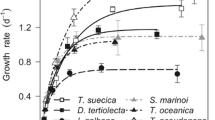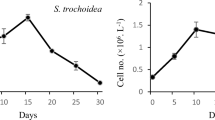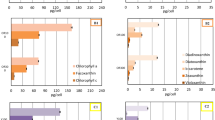Abstract
Chl a and C-normalized pigment ratios were studied in two dinophytes (Prorocentrum minimum and Karlodinium micrum), three haptophytes (Chrysochromulina leadbeateri, Prymnesium parvum cf. patelliferum, Phaeocystis globosa), two prasinophytes (Pseudoscourfieldia marina, Bathycoccus prasinos) and the raphidophyte Heterosigma akashiwo, in low (LL, 35 μmol photons m−2 s−1) and high light (HL, 500 μmol photons m−2 s−1). Pigment ratios in LL and HL were compared against a general rule of photoacclimation: LL versus HL ratios ≥1 are typical for light-harvesting pigments (LHP) and <1 for photoprotective carotenoids. Peridinin, prasinoxanthin, gyroxanthin-diester and 19′-butanoyloxy-fucoxanthin were stable chemotaxonomic markers with less than 25% variation between LL versus HL Chl a–normalized ratios. As expected, Chls exhibited LL/HL to Chl a ratios >1 with some exceptions such as Chl c3 in P. globosa and MV Chl c3 in C. leadbeateri. LL/HL to Chl a ratios of photosynthetic carotenoids were close to 1, except Hex-fuco in P. globosa (four-fold higher Chl a ratio in HL vs LL). Although pigment ratios in P. globosa clearly responded to the light conditions the diadinoxanthin-diatoxanthin cycle remained almost unaltered at HL. Total averaged pigment and LHP to C ratios were significantly higher in LL versus HL, reflecting the photoacclimation status of the studied species. By contrast, the same Chl a-normalized ratios were weakly affected by the light intensity due to co-variation with Chl a. Based on our data, we suggest that the interpretation of PPC and LHP are highly dependent on biomass normalization (Chl a vs. C).


Similar content being viewed by others
Reference
Anderson JM, Chow WS, Park Y-I (1995) The big design of photosynthesis: acclimation of the photosynthetic apparatus to environmental cues. Photosynth Res 46:129–139
Bains S, Richard D, Norris R, Courfield M, Faul KL (2000) Termination of global warmth at the Palaeocene/Eocene boundary through productivity feedback. Nature 407:171–174
Böhme K, Wilhelm C, Goss R, (2002) Light regulation of carotenoid biosynthesis in the prasinophycean Mantoniella squamata. Photochem Photobiol Sci 1:619–628
Cloern JE, Grenz C, Vidergar-Lucas L (1995) An empirical model of the phytoplankton chlorophyll:carbon ratio—the conversion factor between productivity and growth rate. Limnol Oceanogr 40:1313–1321
Egeland ES, Johnsen G, Eikrem W, Throndsen J, Liaaen-Jensen S (1995) Pigments of Bathycoccus prasinos (Prasinophyceae): methodological and chemosystematic implications. J Phycol 31:554–561
Egeland ES, Guillard RRL, Liaaen-Jensen S (1997) Additional carotenoid prototype representatives and a general chemosystematic evaluation of carotenoids in Prasinophyceae (Chlorophyta). Phytochemistry 44:1087–1097
Falkowski PG, Dubinsky Z, Wyman K (1985) Growth-irradiance relationships in phytoplankton. Limnol Oceanogr 30:311–321
Falkowski PG, Raven J (eds) (1997) Aquatic Photosynthesis. Blackwell, Oxford, UK
Fawley MW (1992) Photosynthetic pigments of Pseudoscourfieldia marina and select green flagellates and coccoid ultraphytoplankton: implications for the systematics of the Micromonadophyceae (Chlorophyta). J Phycol 28:26–31
Fenchel T (1988) Marine planktonic food chains. Ann Rev Ecol Syst 19:19–38
Garibotti IA, Vernet M, Kozlowski WA, Ferrario ME (2003) Composition and biomass of phytoplankton assemblages in coastal Antarctic waters: a comparison of chemotaxonomic and microscopic analyses. Mar Ecol Prog Ser 247:27–42
Garrido JL, Otero J, Maestro MA, Zapata M (2000) The main non-polar chlorophyll c from Emiliania huxleyi (Prymnesiophyceae) is a chlorophyll c2-monogalactosyl-diacylglyceride ester: a mass spectrometry study. J Phycol 36:497–505
Goericke R, Montoya JP (1998) Estimating the contribution of microalgal taxa to chlorophyll a in the field-variations of pigment ratios under nutrient-and light-limited growth. Mar Ecol Prog Ser 169:97–112
Goss R, Böhme K, Wilhelm C (1998) The xanthophyll cycle of Mantoniella squamata converts violaxanthin into antheraxanthin but not to zeaxanthin: consequences for the mechanism of enhanced non-photochemical energy dissipation. Planta 205:613–621
Guillard RRL, Ryther JH (1962) Studies of marine plankton diatoms. I. Cyclotella nana Hustedt and Detonula confervacea. (Cleve) Gran Can J Microbiol 8:229–239
Henriksen P, Riemann B, Kaas H, Sørensen HM, Sørensen HL (2002) Effects of nutrient-limitation and irradiance on marine phytoplankton pigments. J Plankton Res 24:835–858
Jeffrey SW, Mantoura RFC, Bjørnland T (1997) Data for the identification of 47 key phytoplankton pigments. In: Jeffrey SW, Mantoura RFC, Wright SW, (eds) Phytoplankton pigments in oceanography: guidelines to modern methods. UNESCO, Paris, pp 449–559
Johnsen G, Prézelin BB, Jovine RVM, (1997) Fluorescence excitation spectra and light utilization in two red tide dinoflagellates. Limnol Oceanogr 42:1166–1177
Johnsen G, Sakshaug E (1993) Bio-optical characteristics and photoadaptive responses in the toxic and bloom-forming dinoflagellates Gyrodinium aureolum, Gymnodinium galatheanum, and two strains of Prorocentrum minimum. J Phycol 29:627–642
Larsen A (1999) Prymnesium parvum and P. patelliferum (Haptophyta)—one species. Phycologia 38:541–543
Latasa M, Scharek R, LeGall F, Guillou L (2004) Pigment suites and taxonomic groups in Prasinophyceae. J Phycol 40:1149–1155
Lefèvre N, Taylor AH, Gilbert FJ, Geider RJ (2001) Modeling carbon to nitrogen and carbon to chlorophyll a ratios in the ocean at low latitudes: evaluation of the role of physiological plasticity. Limnol Oceanogr 48:1796–1807
Llewellyn CA, Gibb SW (2000) Intra-class variablity in the carbon, pigment and biomineral content of prymnesiophytes and diatoms. Mar Ecol Prog Ser 193:33–44
Llewellyn CA, Fishwick JR, Blackford JC (2005) Phytoplankton community assemblage in the English Channel: a comparison using Chl a derived from HPLC-CHEMTAX and carbon derived from microscopy cell counts. J Plankton Res 27:103–119
Lohr M, Wilhelm C (1999) Algae displaying the diadinoxanthin cycle possess the violaxanthin cycle. Proc Natl Acad Sci USA 96:8784–8798
Millie D, Schofield O, Kirkpatrick G, Johnsen G, Tester P, Vinyard B (1997) Detection of harmful algal blooms using photopigments and absorption signatures: a case study of the Florida red tide dinoflagellate, Gymnodinium breve. Limnol Oceanogr 42:1240–1251
Niyogi KK, Björkman O, Grossman AR (1997) The roles of specific xanthophylls in photoprotection. Proc Natl Acad Sci USA 94:14162–14167
Porra RJ, Pfündel EE, Engel N (1997) Metabolism and function of photosynthetic pigments. In: Jeffrey SW, Mantoura RFC, Wright SW (eds) Phytoplankton pigments in oceanography: guidelines to modern methods. UNESCO, Paris, pp 85–126
Riegman R, Kraay GW, (2001) Phytoplankton community structure derived from HPLC analysis of pigments in the Faroe-Shetland Channel during summer 1999: the distribution of taxonomic groups in relation to physical/chemical conditions in the photic zone. J Plankton Res 23:191–205
Sakshaug E, Graneli E, Elbrachter M, Kayser H (1984) Chemical composition and alkaline phosphatase activity of nutrient-saturated and P-deficient cells of four marine dinoflagellates. J Exp Mar Biol Ecol 77:241–254
Sakshaug E, Bricaud A, Dandonneau Y, Falkowski P, Kiefer D, Legendre L, Morel A, Parslow J, Takahashi M (1997) J Plankton Res 19:1637–1670
Schlüter L, Møhlenberg F, Havskum H, Larsen S, (2000) The use of phytoplankton pigments for identifying and quantifying phytoplankton groups in coastal areas: testing the influence of light and nutrients on pigment/chlorophyll a ratios. Mar Ecol Prog Ser 192:49–63
Stolte W, Kraay GW, Noordeloos AAM, Riegman R (2000) Genetic and physiological variation in pigment composition of Emiliania huxleyi (Prymnesiophyceae) and the potential use of its pigment ratios as a quantitative physiological marker. J Phycol 36:529–539
van Leeuwe MA, Stefels J (1998) Effects of iron and light stress on the biochemical composition of Antarctic Phaeocystis sp II Pigment composition. J Phycol 34:496–503
Wright SW, van den Enden RL (2000) Phytoplankton populations off east Antarctica in relation to stratification/mixing regimes: CHEMTAX analysis of HPLC pigment profiles (BROKE survey, Jan-Mar 1996). Deep-Sea Res II 47:2363–2400
Zapata M, Rodríguez F, Garrido JL, (2000) Separation of chlorophylls and carotenoids from marine phytoplankton: a new HPLC method using a reversed-phase C8 column and pyridine-containing mobile phases. Mar Ecol Prog Ser 195:29–45
Zapata M, Edvardsen B, Rodríguez F, Maestro MA, Garrido JL (2001) Chlorophyll c2 monogalactosyldiacylglyceride ester (chl c2?-MGDG) a marker pigment for Chrysochromulina polylepis species (Haptophyta). Mar Ecol Prog Ser 219:85–98
Zapata M, Jeffrey SW, Rodríguez F, Clementson L, Garrido JL, Wright SW (2004) Pigment variability in 37 species (65 strains) of Haptophyta: implications for phylogeny and oceanography. Mar Ecol Prog Ser 270:83–102
Acknowledgements
We thank Dr W. Eikrem for providing cultures of B. prasinos, C. leadbeateri and H. akashiwo. This work has been supported by the HP (Human Potential) Programme from the European Union through contract N° HPRI-1999-CT-00060.
Author information
Authors and Affiliations
Corresponding author
Additional information
Communicated by S.A. Poulet, Roscoff
Rights and permissions
About this article
Cite this article
Rodríguez, F., Chauton, M., Johnsen, G. et al. Photoacclimation in phytoplankton: implications for biomass estimates, pigment functionality and chemotaxonomy. Marine Biology 148, 963–971 (2006). https://doi.org/10.1007/s00227-005-0138-7
Received:
Accepted:
Published:
Issue Date:
DOI: https://doi.org/10.1007/s00227-005-0138-7




